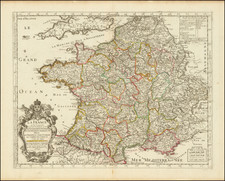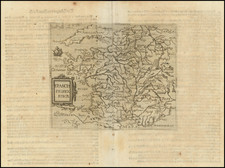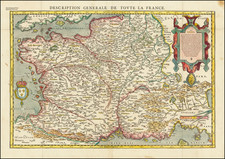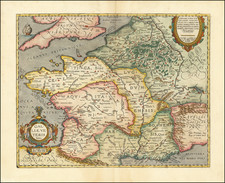From the Collection of General Nicolas Oudinot
Second state of this important map of Paris, shown at the beginning of the re-design of the City during the Reign of Napoleon, dedictated to Count Frochot, the second Prefect of the Department of the Seine (a position created by Napoleon which replaced the Mayor of Paris).
The map reflects the progress of Napoleon's grand plan to remake Paris into a grand imperial city in the style of Ancient Rome. Commenced shortly after Napoleon became Emperor on December 2, 1804, the plan would radically transform the city.
Ironically, within 1 year of the publication of the map, Napoleon met his defeat at Waterloo in June 1815, resulting in the occupation of Paris by the Allied Armies of England, Austria, Russia and Prussia until December 1815 and the restoration of Louis XVI.
Among other notable features, the map locates the Palace of the King of Rome, then under construction, which would later be abandoned, along with the Arc de Triomphe and the Bourse.
The map shows the new buildings and projects in 5 colors:
- Red for the monuments under construction (Ministe..re des Relations Exterieures, Marche Saint-Germain, Halles au vins, Arc de Triomphe)
- Brown for the planned monuments and arreates (Palais de l'Universite, Palais des Archives, Barracks)
- Grey for palaces, monuments and public administrations
- White for Mansions
- City Administrative Buildings in blue.
A box at the bottom on the left entitled "Division of the city and canton of Paris" contains a list of administrative buildings, quarters, courts, prisons and other parts of the city.
General Nicolas Charles Oudinot
A final detail that gives this map particular importance is the identity of its former owner, Nicolas Charles Oudinot, 1st Comte Oudinot, 1st Duc de Reggio (1767 - 1848), and a Marshal of France. A fierce fighter, the man was wounded no less than 34 times during his military career!
The only one of nine siblings to live past childhood, Oudinot joined the army without a noble pedigree, and therefore without a chance of high promotion. That all changed in 1792, with the outbreak of the French Revolution. In that year, Oudinot was elected lieutenant-colonel of the third battalion of the volunteers of the Meuse. After transfer to the regular army and admirable service in Belgium, he was promoted to the rank of general in June 1794 after the Battle of Kaiserslautern.
From Belgium he shifted to the German and Swiss fronts, where he fought as a general of division and chief of staff to Andre Massena. Oudinot stood out at the Battle of Monzambano so much so that Napoleon himself presented him with a sword of honor, now known as the Legion d'Honneur. Napoleon did not forget him after he established his empire; now Emperor Napoleon recognized Oudinot again, this time with a Grand Cross of the Legion of Honor.
During the Napoleonic Wars, Oudinot continued to acquit himself commendably. He was elected a member of the Chamber of Deputies, commanded a company of grenadiers nicknamed for him, and fought in battles from Vienna to Poland. In 1808, he was appointed governor of Erfurt and was made a Count of the French Empire. Finally, in 1809, after the Battle of Wagram, he was named a Marshal of France, France's highest military distinction.
Oudinot continued to serve as an administrator in Holland and on the battlefield in the Russian campaign. After Napoleon's fall, Oudinot joined the Bourbon Restoration and stayed loyal to the King even after Napoleon's return in 1815. For his loyalty and service, he was named a peer of the realm. He served until 1823, when he participated in the French invasion of Spain. Then, he turned again to political and administrative appointments; he died while serving as governor of Les Invalides, at the veterans' hospital in Paris.
Provenance
Purchased at auction in Paris, from Artcuriel, Collections from the Castle of Malicorne Marshal Oudinot's Historical Souvenirs, June 13, 2017 (Lot 156).











![[La Rochelle] Rochella Munitissimum Galliae Opp.](https://storage.googleapis.com/raremaps/img/small/77250.jpg)
![[France]](https://storage.googleapis.com/raremaps/img/small/77774.jpg)

